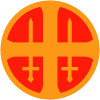|
Hirden
Hirden[1] (the hird) was a uniformed paramilitary organisation during the occupation of Norway by Nazi Germany, modelled the same way as the German Sturmabteilungen.[2] OverviewVidkun Quisling's fascist party Nasjonal Samling frequently used words and symbols from the old Norse Viking era. During the Second World War, membership was compulsory for all Nasjonal Samling members. In total, about 8,500 Norwegians were members of Hirden during the war. The organisation was dissolved after the liberation, and many of its former members were prosecuted and convicted for treason and collaboration. HistoryDuring the German occupation Hirden got a more military slant. The intention was that it should form the nucleus of a future Norwegian Nazi army, and a "hirdmarine" (Hirden navy)[3] and a "Hirdens flykorps"(Hirden's air force corps)[4] were created in 1942 in addition to the real Hirden, Rikshirden. However, many Hirden members volunteered to Norwegian military units in the war on Nazi German side or served as guards in the various prison camps. Hirden had a broad mandate to conduct operations against dissidents, independent of all police authorities, many of which included the use of violence.[5] A 2014 Dagsavisen article said that "8 of 10" prisoners "died in the prison camps where Hirden performed guard duty under the leadership of SS".[6] List of Hirden branchesMain Hirden organisations
Related organisations not directly subject to the Rikshirden
Youth organisations with Hirden names
Gallery
Ranks and rank insignia
See alsoReferences
Sources
External links
|
|||||||||||||||||||||||||||||||||||||||||||||||||||||||||||||||||||||||||||||||||||||||||||||||||||||||||||||||||||||||||||||||||||||||||||||||||||||||||||||||||||||||||||||||||||||||||||
























